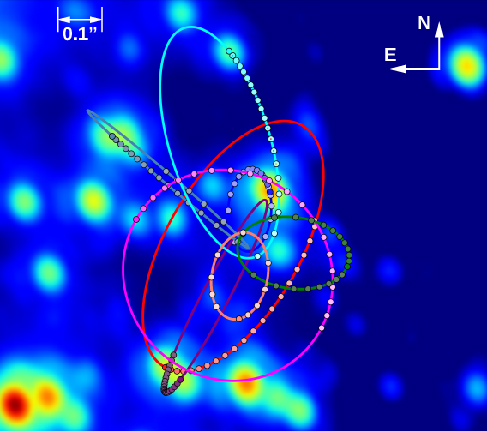| << Chapter < Page | Chapter >> Page > |
First, let’s look at how the mass can be measured. If we zero in on the inner few light-days of the Galaxy with an infrared telescope equipped with adaptive optics, we see a region crowded with individual stars ( [link] ). These stars have now been observed for almost two decades, and astronomers have detected their rapid orbital motions around the very center of the Galaxy.

Check out an animated version of [link] , showing the motion of the stars over the years.
If we combine observations of their periods and the size of their orbits with Kepler’s third law, we can estimate the mass of the object that keeps them in their orbits. One of the stars has been observed for its full orbit of 15.6 years. Its closest approach takes it to a distance of only 124 AU or about 17 light-hours from the black hole. This orbit, when combined with observations of other stars close to the galactic center, indicates that a mass of 4.6 million M Sun must be concentrated inside the orbit—that is, within 17 light-hours of the center of the Galaxy.
Even tighter limits on the size of the concentration of mass at the center of the Galaxy come from radio astronomy , which provided the first clue that a black hole might lie at the center of the Galaxy. As matter spirals inward toward the event horizon of a black hole, it is heated in a whirling accretion disk and produces radio radiation. (Such accretion disks were explained in Black Holes and Curved Spacetime .) Measurements of the size of the accretion disk with the Very Long Baseline Array, which provides very high spatial resolution, show that the diameter of the radio source Sagittarius A * is no larger than about 0.3 AU, or about the size of Mercury’s orbit. (In light units, that’s only 2.5 light- minutes !)
The observations thus show that 4.6 million solar masses are crammed into a volume that has a diameter that is no larger than the orbit of Mercury. If this were anything other than a supermassive black hole—low-mass stars that emit very little light or neutron stars or a very large number of small black holes— calculations show that these objects would be so densely packed that they would collapse to a single black hole within a hundred thousand years. That is a very short time compared with the age of the Galaxy, which probably began forming more than 13 billion years ago. Since it seems very unlikely that that we would have caught such a complex cluster of objects just before it collapsed, the evidence for a supermassive black hole at the center of the Galaxy is convincing indeed.

Notification Switch
Would you like to follow the 'Astronomy' conversation and receive update notifications?